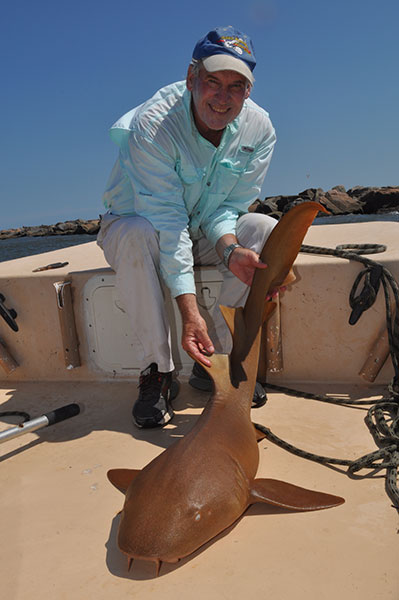
Mike Marsh caught this nurse shark during Shark Week.
The latest deluge found us searching for some clear water. The crashing water temperatures from the cold rain and the turbidity from the runoff had the inshore fish a bit out-of-sorts. While we tried several places, I eventually, took my wife, Carol, fishing at Masonboro Inlet, where we were looking for the tide line.
The contrast of the brick-colored water dumping into the Atlantic from the Intracoastal Waterway with the cleaner ocean water was stark. Despite it being a Sunday afternoon, only a few other anglers were fishing.
"The fish must not be biting, or the inlet would be crowded," Carol said. "At least the fishing is comfortable."
Indeed, a southwest wind was blowing hard. Anchoring the 20-foot flat bottom boat in lee of the south jetty had been a good idea.
Waves crashed against the end of the jetty, so we stopped halfway along the rocks. We hooked live mullet and tossed them against the base of the rocks, hoping for a red drum, flounder or bluefish. Instead, we caught undersized sea bass and oversized oyster toadfish.
I was ready to haul anchor and head for home when a big fish struck. I picked up the rod and set the hook.
We took turns guessing the identity of the fish, wavering between a cobia, a red drum and a stingray. But, all of our guesses were wrong.
"It's a shark!" Carol shouted. "What do you want me to do?"
I told her to get the camera. Then I battled the shark until it was near enough to identify it as a nurse shark. I could not remember catching one in my lifetime. It certainly seemed appropriate, with TV and other media, including the Wilmington Star-News focusing on sharks at this time of the summer.
As the fish circled, I noticed a leader dangling from its gill. I did not want to harm the shark and I knew that anglers have little to fear because nurse sharks lack external teeth. Eventually, I encircled the front of the fish with rubber net and brought it aboard. I did not want to keep the fish, although it is a legal species with a bag limit of one per day per vessel with a minimum fork length of 54 inches. My intent was to remove the hook and wayward leader before setting the shark free.
Fascinated by how some oddly named fish's received their common names, I like to do some sleuthing to discover how some species may have acquired them. As soon as the shark was aboard, its mouth opened and closed, making sucking sounds like those of a calf suckling at its mother's udder. I assume that is how the nurse shark got its angler's name.
With Carol shooting images, I wrestled the fish onto the bow, marveling at the coarseness of its skin. The superfluous leader had its hook in a gill cover and the swivel dangling outside the gill. My guess is that another angler had recently released the fish by cutting the leader above the swivel. It is also possible the fish had broken the swivel knot.
After releasing the shark, we headed home. I checked Vic Dunaway's book, "Sport Fish of the Atlantic" and found that nurse sharks range from Cape Hatteras to South Florida, where they are most abundant. Its food quality is excellent. However, its sporting qualities come in dead last in the shark category.
Still, on a light action rod with a flounder rig, it was more than enough thrill for an afternoon and we added another unusual fish to our lifetime list.
